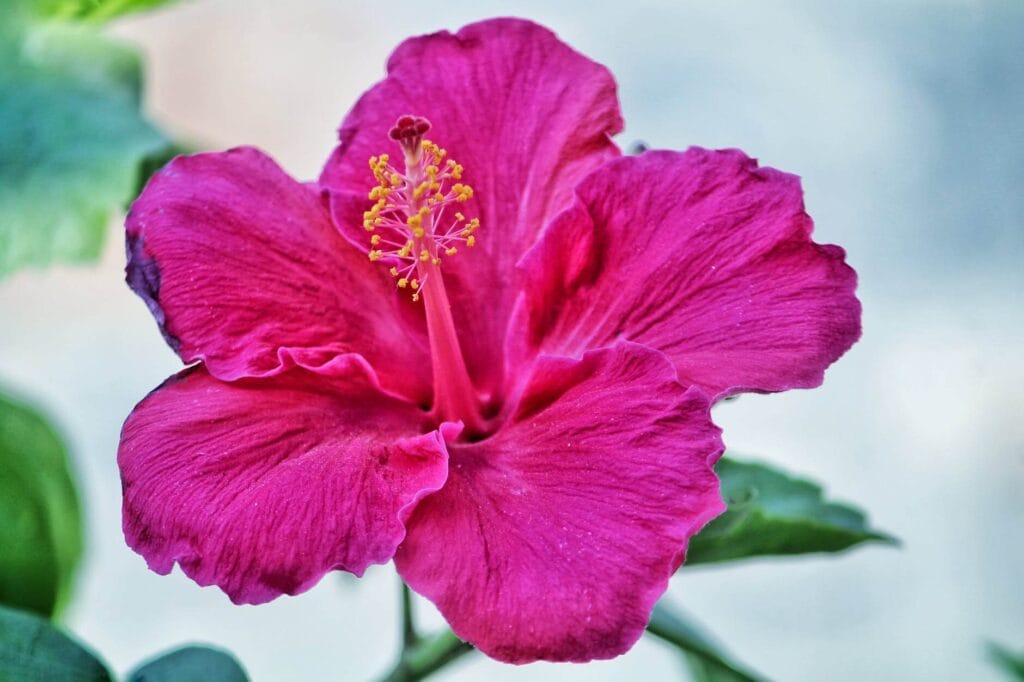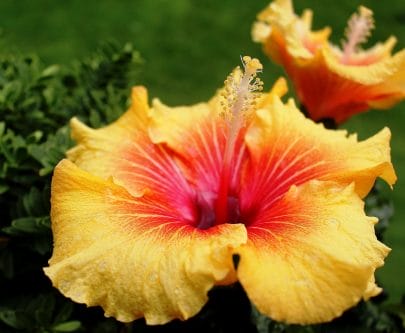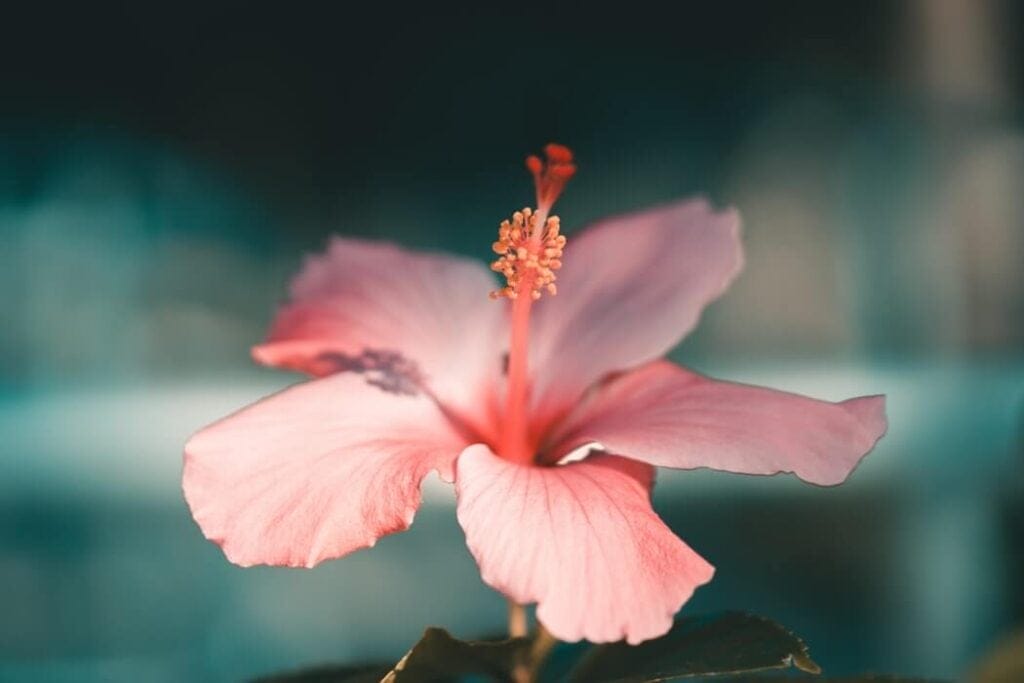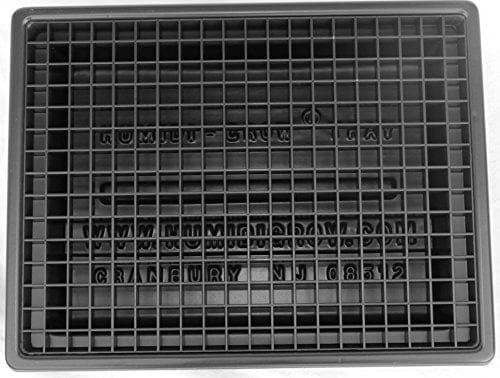Are you growing a Hibiscus plant and want the Ultimate Guide for Hibiscus Care?
Are you interested in adding a tropical plant to your garden both indoors and potentially outdoors?
Or are you a beginner gardener that just wants to learn more about Hibiscus?
After years of perfecting Hibiscus growing and care, I have created the Ultimate Guide to Indoor Hibiscus Care.
If you follow this guide you will be rewarded with beautiful flowers and healthy plants for years.
3 Types of Hibiscus
While this article is mainly focused on Hibiscus Care, it is essential to have a general understanding of the three types of Hibiscus.
Understanding each type of Hibiscus will allow you to better determine which one you should purchase for your climate.
Regardless of the Hibiscus plant you decide to purchase or already have, the overall Hibiscus care is generally the same.
Rose of Sharon

The Rose of Sharon is a tall, woody shrub that is a perfect plant for edges in your garden or yard.
This plant has a bright red center, can be pruned into a tree form, and can grow up to 12 feet tall.
If you live in Hardy Zones 5-8 then this type of Hibiscus plant is perfect for you.
And this type of Hibiscus plant is perfect for areas that have droughts or lots of heat.
I do recommend placing it in an area that gets afternoon shade.
Best of all is that this is one of the better plants to attract hummingbirds and butterflies.
If you want to learn more about how to attract hummingbirds then I recommend reading: How to Attract Hummingbirds: 44 PROVEN Tips (2019)
Tropical Hibiscus

When you have seen pictures of Hibiscus you have probably seen Tropical Hibiscus.
Tropical Hibiscus grows in hardy zones 9 to 11 and is a perfect container plant.
The tropical hibiscus looks like a low growing shrub and has double bloom in multiple vibrant colors.
The blooms of the flowers are approximately 6 inches big and usually are the flower of choice that women wear in their hair.
It should be noted that this plant should be brought inside if the weather drops below freezing temperatures.
Hardy Hibiscus

Hardy Hibiscus is a bush-like plant that has flowers that can be as large as dinner plates.
This dynamic plant grows in hardy zone 4 and is a late summer bloomer. When it blooms it has intense colors of red, white, and pink.
It should be noted that the blooms only last for one day.
This is another amazing hibiscus to grow in a container and a great way to attract butterflies and hummingbirds.
10-Step Guide to Hibiscus Care
Hibiscus plants are beautiful perennials that bloom every single year if you properly care for them.
Not only this, but Hibiscus is one of the few tropical plants that you can grow anywhere no matter your climate.
Step 1: Caring for Outside Hibiscus
Caring for Hibiscus that is planted outside is very similar to caring for Hibiscus plants indoors.
However, there are some small differences that you want to pay close attention to.
1. Freezing Temperatures
If your hibiscus is planted in a climate that has below freezing temperatures immediately replant it from the ground into a container.
2. Well-Draining Soil
If you have your hibiscus planted in the ground make sure it is in soil that is well-draining and has had peat moss or compost added to it.
If you want to add some of the best quality sphagnum peat moss then I recommend: Hoffman’s sphagnum peat moss.
3. Full – Sun
Make sure where ever your hibiscus is planted it receives full-sun with some afternoon shade.
4. Bloom Temperature
If you want to enjoy beautiful hibiscus bloom then you will make sure your plant receives a temperature of 75 degrees Fahrenheit.
If you live in a climate that does not receive this temperature during the year then I recommend repotting your hibiscus and moving it indoors.
5. Water, Water, Water
In the summer, make sure you water your hibiscus 3-4 times a week to ensure proper plant growth and blooming.
6. Fertilize Often
In the summer, you will also want to make sure you fertilize every two weeks and then once a week in the winter.
If you want to use one of the best fertilizers out there then I recommend Carl Pool Hibiscus Food.
Step 2: Grow Hibiscus in a Container
You may be tempted to grow your hibiscus in the ground no matter where you live.
I would like to discourage you from doing this.
Most hibiscus grown in the ground where temperatures can potentially freeze almost always results in the death of the plant.
Instead, I recommend planting your hibiscus in a container.
The reason I recommend planting your hibiscus in a container is that it will allow you to consistently move it to the ideal location (indoors and outdoors) during the year.
By doing this, you will be able to control the amount of sunlight, water, and humidity your hibiscus receives at any given point.
This means more blooming flowers more often.
My last tip when planting your hibiscus in a container is to make sure it is a cozy fit.
A cozy fit means the plant should snuggly fit into the container.
And don’t forget to purchase a planter that has holes to help the water drain to prevent root rot.
Step 3: Use Only THIS Potting Mix
If you want your hibiscus to properly grow and continuously bloom then potting mix is your foundation.
All three types of hibiscus thrive in loamy, lightweight and well-drained potting mix. If you are able to add a cup of perlite to the potting mix (or if it already comes with perlite) that is even better.
If you want the best potting mix for your hibiscus then I recommend purchasing Miracle-Gro Expand n Gro Planting Mix.
Step 4: Control the Sunlight
Unlike other plants, there is such a thing as too much sunlight for your hibiscus.
Hibiscus plants grow best with at least 6 hours of sunlight, but not all-day sunlight. In addition, they thrive in afternoon shade.
What I recommend is placing your hibiscus in the south or southwest facing a window of your house where it will get just the right amount of light.
Step 5: Control the Heat
Because hibiscus is tropical plants they love and thrive in the heat.
But for hibiscus to bloom it does not require hot weather.
If you are looking for your Hibiscus to grow I recommend keeping it in heat that is between 60 and 90 degrees Fahrenheit.
If you do not have a part of your house that stays within this range then I recommend purchasing a grow light.
Grow lights are great ways to provide specific heat to your hibiscus during specific times of the day and year to provide the best environment for growth.
If you are looking for your plant to bloom in the summer, I recommend keeping it in a place that receives approximately 70-75 degrees Fahrenheit.
And remember, never let your hibiscus be in an area where there are freezing temperatures. Any temperature below freezing will immediately kill your plant.
Step 6: Provide Humidity
Like other tropical plants, hibiscus thrives in humid conditions.
Because most of don’t live in year-round humid conditions, I recommend purchasing a humidity tray.

Humidity Trays are so easy to use that anyone can do it!
All you have to do is place water into the tray and it will slowly evaporate causing the humidity your hibiscus plant needs.
Step 7: Properly Water your Hibiscus
Watering your hibiscus may be one of the trickiest parts of hibiscus care.
I recommend four tips when watering your hibiscus:
- Only water hibiscus with warm water (approximately 95-degree Fahrenheit). Cold-water will not properly be absorbed and can potentially stunt your plant growth.
- In the winter, only water your hibiscus when the soil is dry to the touch
- When your hibiscus is growing, water it at least once to twice a week.
- When your hibiscus is blooming, water it 3 to 4 days a week. Your plant will need at least 1 inch of water a week.
Step 8: Don’t Forget to Fertilize
When it comes to gardening some plants require fertilizer every now and then, while others don’t require fertilizer at all.
Hibiscus plants though require lots of nutrients to grow.
During the summer, you should fertilize your hibiscus frequently with a high potassium solution.
If you use a diluted liquid fertilizer you should fertilize weekly.
If you use a slow-release fertilizer, then you should fertilize monthly.
Adding a high-potassium compost solution to your hibiscus plant in the spring can also help with growth and flower bloom.
If you want the best fertilizer for your hibiscus plant then I recommend using Carl Pool Hibiscus Food.
During the winter months though I recommend that you never fertilize. Over-fertilizing can lead to root burn that will stunt and potentially kill your plant.
Step 9: Do Not Prune
Step 9 is an unusual step when it comes to house plants.
If you want your hibiscus flowers to bloom then do not prune your plant.
Pruning your plant can cause a late showing of your bloom or even delay your bloom by a year.
Instead, focus on deadheading your dead or diseased flowers.
Deadheading is removing fading or dead flowers to improve appearance, prevent seeding, and provide more blooms.
Deadheading your hibiscus flowers will not provide more blooms but instead will improve appearance, prevent seeding, and provide better blooms for the following year.
Step 10: Do THIS to Prevent Premature Hibiscus Leaf Fall
One of the most common problems that occur during hibiscus care is premature leaf and flower bud fall.
There are numerous reasons for premature leaf and flower bud fall.
One of the main reasons for premature flower and leaf fall is from Thrips.
Thrips are tiny insects that feed on flowers which then causes them to fall off.
Another reason for premature leaf and flower fall can be from Gall midge, which lay eggs inside the buds of the flowers turning them yellow (and then falls off).
Other insects that can cause premature leaf and flower fall are spider mites, mealy bugs, aphids, whiteflies, and the hibiscus beetle.
If you want to help prevent these insects from infecting your hibiscus plant then I recommend purchasing an insecticide, such as Safer Brand Insect Killing Soap.
Apply your insecticide once a week for best results.
Other causes of premature leaf and flower fall can be from the environment or nutritional deficiencies.
And finally, insufficient or excessive watering, fertilizer, and temperatures can cause premature leaf and flower fall.
None of these will be a problem for you though if you diligently follow my 10 Steps of Hibiscus Care.
Bonus Tip: How to Get More Hibiscus Plants for FREE
Do you love hibiscus plants so much you want more?
What if I can tell you of a simple way to get more hibiscus plants for FREE?
If you want more hibiscus plants for free then I recommend performing a hibiscus care technique called propagation.
Propagation is taking cuttings from an easy plant and using to grow a brand new hibiscus.
If you want to learn how to propagate cuttings then follow my simple steps below.
- Begin by cutting new growth (a greenish color and a soft branch) in spring or early summer.
- Cut 4 to 6 inches worth of the branch. Cut slightly under the bottom leaf node. A leaf node is a bump where the leaf was growing.
- Remove everything but the top set of leaves
- Dip the cutting in root hormone.
- Place the cutting in a very small pot and use the potting soil you bought in the above section.
- Place the pot in the shade. Some people recommend wrapping it with a plastic bag, but studies have shown no positive effect from this.
- Water your cutting until the soil is a dark brown color.
- Cuttings will take about 8 weeks to root. After 8 weeks repot your hibiscus into a bigger container. Provide all 10 steps of hibiscus care as seen above.
- Repeat these 8 steps for however many new hibiscus plants you want.
If you prefer to watch a propagating video then I recommend the below short tutorial.
Conclusion
As you have seen, hibiscus care is very easy if you follow the simple steps that I provided you.
To ensure the best hibiscus growth and flower bloom I recommend the following care:
- Only plant your hibiscus in the ground if you expect year-round weather that is above freezing!
- I recommend planting your hibiscus in a snug container. This will give you the ability to move your plant around all year for the perfect temperature, sunlight, and humidity.
- Hibiscus is a hardy tropical plant. But it is not invisible. Because of that use only the suggested potting mix that I recommended.
- Hibiscus need only six hours of sunlight. And for best results, hibiscus enjoys afternoon shade.
- If you don’t live in a climate that has the proper heat then put your hibiscus under a grow light. And remember the ideal temperature for flower bloom is 75 degrees Fahrenheit.
- If you want the best success with hibiscus care then you have to provide your plant with humidity. Humidity is key to growth and bloom. I recommend using a humidity tray no matter where you live.
- When your hibiscus plant is blooming water it three to four times a week.
- Unlike other plants, hibiscus requires more frequent fertilization. In the summer months, fertilize every two weeks.
- Do NOT Prune your fig tree. This can prevent future blooms.
- Use Insecticide to help prevent disease and premature leaf and flower drop.
- And finally, use propagation if you want free hibiscus FOREVER!
What’s Next
If you found this article then I recommend reading:
How to Care for Orchids: 10 EASY & PROVEN Tips
101 Gardening Tips that ACTUALLY Work
Ultimate Guide to Starting a Vegetable Garden
What is your favorite type of Hibiscus?
Do you have any tips you use for hibiscus care?


